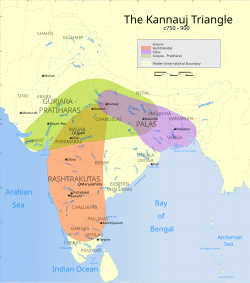Ancestry
Previously, the historians believed that Shurapala and Vigrahapala were the two names of the same person. However, the discovery of a copper plate in 1970 in the Mirzapur district conclusively established that these two were cousins. They either ruled simultaneously (perhaps over different territories) or in rapid succession. [1] : 32–37 If they ruled in succession, it seems more likely that Shurapala preceded Vigrahapala, since Vigrahapala I and his descendants ruled in unbroken succession. Vigrahapala either dethroned Shurapala, or replaced him peacefully in absence of any direct heir to the throne. [2]
Earlier, it was believed that Shurapala and Vigrahapala succeeded Devapala. However, the discovery of a copper plate charter at Jagjivanpur indicates that Shurapala was preceded by Mahendrapala. Both were sons of Devapala and his queen Mahata. [3] According to the Jagjivanpur inscription Shurapala I was Mahendrapala's younger brother and royal envoy. [4]
This page is based on this
Wikipedia article Text is available under the
CC BY-SA 4.0 license; additional terms may apply.
Images, videos and audio are available under their respective licenses.


